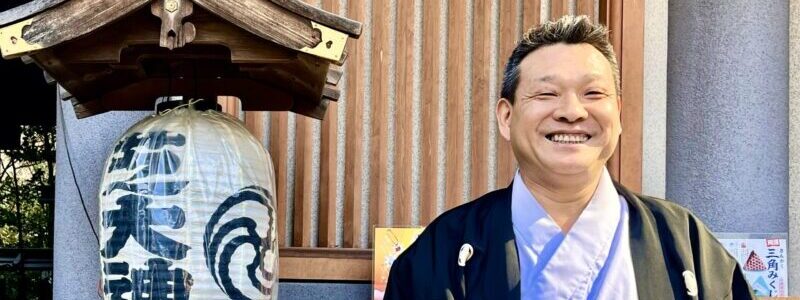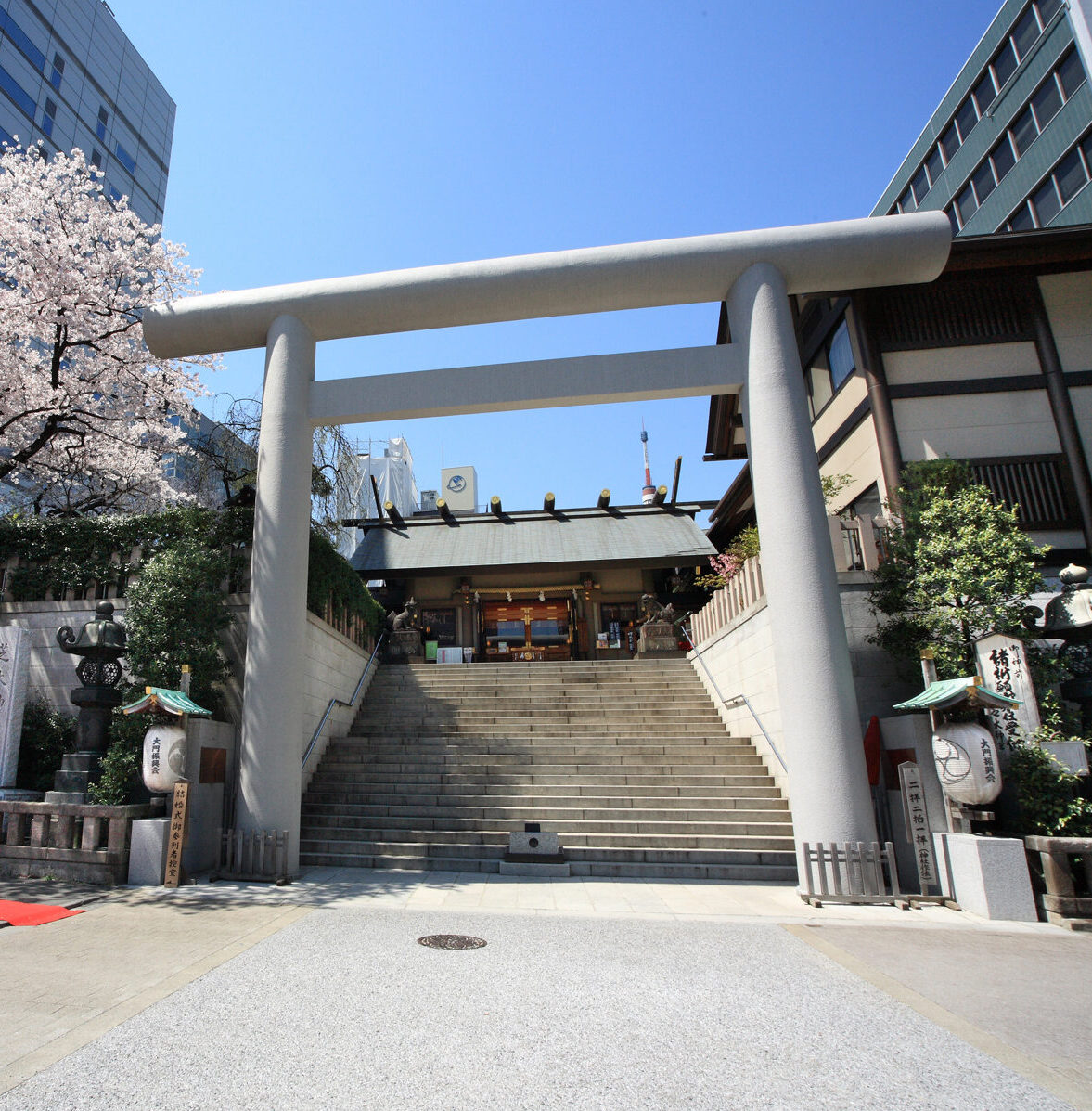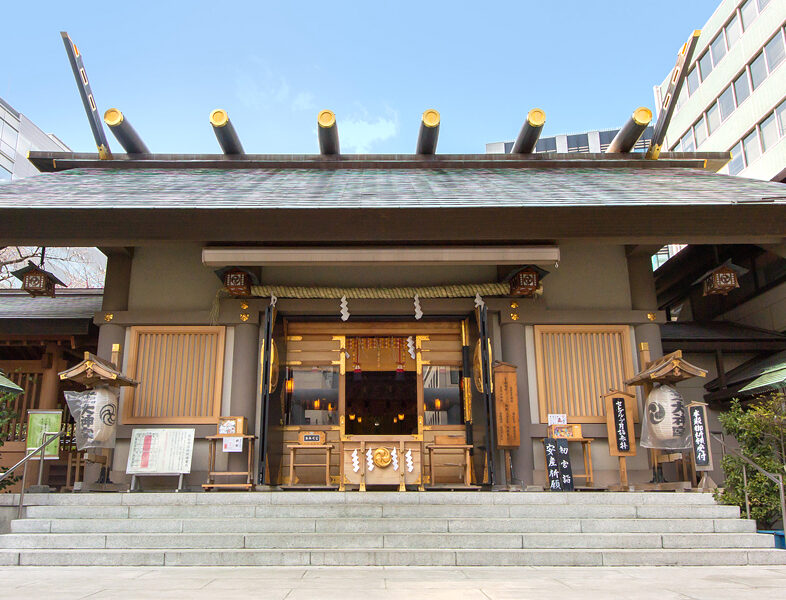
Meet Hiroyuki Katsuta at “Shiba-daijingu”, which is called “O-Ise-sama of the Kanto area”.
Hiroyuki Katsuta, the chief priest of “Shiba-daijingu,” known as “O-Ise-sama of the Kanto area,” is warmly embraced by the people. Despite bearing the weighty responsibility as the 60th chief priest, he radiates a powerful and cheerful energy that goes beyond the conventional image of a priest. He believes the chief priest should remain neutral between gods and humans. He says, “This area has depth in history and space, where people can relax and be themselves.” You catch a glimpse of the embracing atmosphere of the Shiba area.
History of Having Loved by People
The predecessor of Shiba-daijingu is the “Iikura Shinmeigu,” established in 1005 in Iikura as a base for storing rice from the Kanto area to offer to Ise-jingu. Later, when the Tokugawa family, who established the shogunate in Edo, chose Zojoji as their family temple, it was said that the Iikura area was considered unfavorable in terms of direction towards Zojoji. Under the protection of the Tokugawa shogunate, the shrine was relocated to Shiba.
There was a trend of making a “once-in-a-lifetime pilgrimage to Ise” in the Edo era. However, the journey from Edo to Ise and back on foot took around 50 days, and it cost approximately 1.5 million yen in today’s currency. It wasn’t something people could easily afford. To address this, they divided the divine spirit and established Shiba-daijingu, known as the “O-Ise-sama of the Kanto area.” People from Kanto and northern regions, who were relatively far from Ise, started visiting Shiba-daijingu instead. Those starting a journey from Edo to Ise would stop by this shrine located at the entrance of the Tokaido, offer prayers saying, “I’m off,” and take a small rest. It has a long history of being beloved by the common people.
In September, there is an annual grand festival, known as “Dara-dara Matsuri.” It was only on September 16th initially, but it was extended to five days before and after, making it an 11-day celebration to accommodate visitors from all over the country. Written in kanji meaning “thick” and “good,” it is considered auspicious, and many people choose to have their weddings during this festival.

As the 60th Chief Priest
I worked at the German pharmaceutical company after graduating from university. I returned at the age of 35 to take over the family business, but it was tough to resign since I loved my job. My grandfather left a book that said, “Born into destiny, challenge life, and burn with heavenly fate. Then, life becomes a grand path, the ecliptic,” and I’ve essentially lived my life in that way.
Inheriting a family profession is a unique life experience. I spent New Year’s Eve and New Year’s Day alone since childhood. I used to feel lonely spending time at other people’s homes. After becoming a chief priest, I’ve found that being in the top position can be lonesome too.
As the 60th chief priest, I serve taking on the role of connecting history by not tarnishing the reputation of my predecessors and shining a light on those who will take over in the future. But I am who I am. Being a Shinto priest holds a neutral position between the gods and people. It means not leaning too close to the gods and staying true to myself as a human.
No matter how much I drink, I clean the shrine every morning at 6:30. As a result, I often see top executives from major companies coming to pray early in the morning. I hope this place can be a source of support, even if it’s just a little.

Charms of This Town
Shiba was written in kanji meaning “ambition” and “waves” in the past. This is because artisans with aspirations came here, started from scratch, underwent training, and achieved great success. With the recognition of this prosperous history, the World Trade Center Building was built here. Furthermore, in the redevelopment of the Reiwa era, it became a twin tower, serving as a hub for land, sea, and air. The local community did not oppose this redevelopment. It was because the World Trade Center Building had built a very good relationship with the locals.
As a child, our territory extended as far as we could see the World Trade Center Building. Even when we went far for crayfish fishing, the sight of that building reassured us, saying, “We can always find our way back as long as we can see that building.” People in the community who carry such memories in them live freely within the four-dimensional expanses, including the dimension of time. Therefore, they are open to new companies arriving and have the capacity to coexist with both the new and the old. Visitors coming for MICE events are also very welcome.

information
【Hiroyuki Katsuta】
Chief Priest of Shiba-daijingu.
After graduating from university, worked at the German pharmaceutical company. Leaving the company and later became the chief priest of Shiba-daijingu. Currently serving as the 60th chief priest of the shrine.
【Shiba-daijingu】
- Address:
- 1-12-7 Shibadaimon, Minato-ku, Tokyo
- Opening hours:
-
Office reception 9:00~17:00
Prayer reception 9:00~16:30 - Website:
- https://www.shibadaijingu.com/



